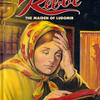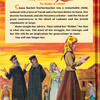7: Source sheet, Bruriah, and cover art and text, Gershon Winkler’s "They Called Her Rebbe: the Maiden of Ludomir," 1990.
The “Yentl” story centers on the belief that the study of Torah is antithetical to a woman’s role in Judaism; yet, women throughout history have rejected a dichotomy of male and female roles, and have studied Torah. Bruriah and the Maid of Ludomir are two examples of women who did so. An article about Bruriah is available on Jewish Encyclopedia. An article about the Maid of Ludomir is available on the Jewish Women's Archive.
Suggested Activity: Ask students to read the excerpts from the sources, and invite them to think about why Torah study was often considered taboo for women. Point to the famous women in the sources who challenged this view. Consulting the Bruriah source sheet, ask the students about the portrayal of a woman studying Torah. How do they characterize Bruriah (spelled Berurya in the passage)? Then ask them to consider the book cover. What do they notice about it? How does it depict a woman who studied Torah in the 19th century (like Yentl)? Discuss ways in which gender roles and expectations have and have not changed since Singer wrote the story (published in English in 1962) and since Streisand adapted it (released in 1983).
Sources: “Bruriah” Source Sheet created in Sefaria. Pesakhim 62b: 9-10. English from The William Davidson digital edition of the Koren Noé Talmud, with commentary by Rabbi Adin Even-Israel Steinsaltz.
Norman, Nodel. 1990, They Called Her Rebbe: The Maiden of Ludomir, Gershon Winkler, Judaica Press, Inc., 1990, front cover.


